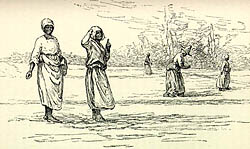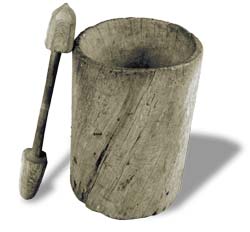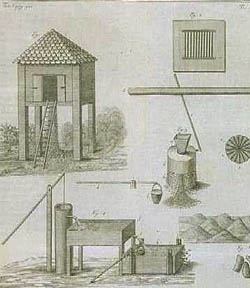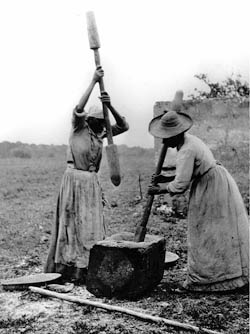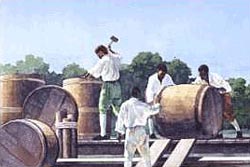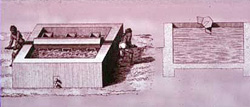Gender, Work and Culture Change
South Carolina Gold
“The Planters in General have throve and grown Rich…by the help and Labour of their Slaves [for their Lands tho’ ever so fertile are of no use or profiut without them]
(Richard Hill to Richard Taunton, June 23, 1743, Richard Hill Letterbook, Duke; George Millidgen [-Johnston], A Short Description of the Province of South Carolina as cited in Morgan 1998:146)
Aside from raising subsistence crops, clearing land and building housing for themselves and the English planters, throughout, the late 17th and early 18th century, African and Low Country-born African men worked as cow boys. They raised, herded and ferried livestock from place to place in Carolina. All of that changed around the turn of the century with the development of rice as a cash crop for export to England and from there to Europe. Rice cultivation and processing were mainly women’s work. So it was in Africa and so it was on South Carolina and Georgia rice plantations, a field labor force that was disproportionately female characterized rice cultivation. Enslaved men carried out skilled work making barrel staves for the crop’s shipment. They monopolized blacksmithing, and cooperage and the hard work of preparing rice embankments and ditches (Carney 2001:199–120).” However, without African women and their daughters, the phenomenal explosion of the South Carolina rice-based economy arguably, would not have occurred.
Between 1730–1774 the critical decades during which tidewater rice export grew from 17 million pounds of rice annually to 66 million pounds, resulted in the economic transformation of Low Country colonies. Between the 1720s and the 1760s, the white population had a 2.0 to 2.2 percent annual growth in per capita income from “South Carolina Gold,” as rice came to be called (Colcanis 1985:253–255). For the enslaved African people, particularly the women upon who successful rice production depended; there was an accompanying increase in hard labor and physical disability.
In the freshwater flood plains of the Sahel, especially where Mande languages were spoken, women, and their daughters carried out all the field operations including rice farming during the 17th and 18th centuries. Women also carried out the specialized tasks of sowing and weeding rice in the upland-inland swamp–planting rice system, located in the southern part of the West African rice-growing region, a place where Mande linguistic groups have flourished since the 12th century. In the valley bottom of this upland-swamp system, the cultivation of rice was and still is the domain of women. In all three of these rice-growing systems, cultivation, processing, and cooking rice are the exclusive domain of women. Enslaved African women transferred this agricultural technology to rice cultivation in Low Country. Archival and historical sources confirm that female slaves made up the majority of “prime hands” on Carolina and Georgia rice plantations (Carney 2001:199 ftn 26).
Rice Cultivation
African women brought three rice cultivation techniques to the Carolina plantations: sowing in trenched ground, open trench planting and tidal rice cultivation. In the 18th century, they used techniques very similar to those used in the 19th century American South and in present day African countries. Elizabeth Pringle description of enslaved people’s preparation of rice for open trench planting in the 19th century corresponds with the contemporary rice planting system in Sierra Leone as well as with descriptions of late 18th early 19th centuries methods used in South Carolina:
“Young men brought the clay water in piggies[sic] from the barrel and poured it over the rice, while young girls, with bare feet and skirts well tied up, danced and shuffled the rice about with their feet until the whole mass was thoroughly clayed,…When it is completely covered with clay, the rice is shovelled [sic] into a pyramid and left to soak until the next morning, when it is measured out into sacks, one and one-fourth bushels to each half acre…(Pringle 1914:375–376).”
Enslaved women pressed the rice seeds into the muddy ground with their heels. Afterwards men called “trunk minders” flooded the fields to encourage seed germination.
“It is literally casting one’s bread on the waters,”…Pringle continues,…“for as soon as the seed is in the ground the trunk door is lifted and the water creeps slowly up and up until it is about three inches deep on the land. That is why the claying is necessary; it makes the grain adhere to the earth, otherwise it would float (Pringle 1914:12–13).”
Once the seeds sprouted, enslaved men drained the fields and the women weeded them. Weeding the rice fields had to be done by hand. The fields were then alternately flooded and drained to keep the soil moist and the weeds under control, and to deter the birds and other animals. The final flooding took place under the watchful eye of the “trunk minder,” who was responsible for gradually raising the water level in the fields to support the top-heavy rice stalk.
“Trunk minder” was a highly skilled occupation that apparently took years to master and that relatively few men achieved. There are only four trunk-minders in a listing of 105 enslaved men for sale by seven different South Carolina slave owners of the 1850s (Stampp 1985). This may indicate that trunk minders were highly valued so not often sold, or that very few men learned the skill.
After harvesting the rice, allowing for a short period during which it dried, the enslaved women processed the rice. Charles Ball describes his experience cultivating rice while enslaved in the Low Country.
Rice Processing
First, they threshed the rice to remove the rice grains from the stalks. Threshing entailed beating the rice with a stick or having the farm animals trampling the stalks.
As early as 1500 BC, West African women were processing rice using a hand-pounding mortar and pestle to separate the indigestible hulls from the rice (Careny 2001). Early on, South Carolina planters recognized the need to mechanize the pounding process: “Procure and Send us by ye: first opportunity a moddell [sic] of a Rice Mill” they recorded in the Journal of the Commons House of Assembly of South Carolina for the two sessions of 1698:36.” However, for another hundred years hand pounding was the primary system used in Low Country until Jonathan Lucas developed the water-driven mill in the late 18th century.
After the enslaved women pounded the rice, they poured it onto a fanner for winnowing. Then they removed the indigestible hulls or chafe by tossing the rice up and down in the wide shallow fanner basket. During this process the basket was gently tilted back and forth, tossing the rice upward and outward, allowing the husk to be blown away by the wind.
In 18th century South Carolina, African women made the winnowing baskets from light grasses and palmetto leaf. Anthropologist Dale Rosengarten has established that the weaving style of winnowing baskets and the process of winnowing passed down from South Carolina slaves to their Low Country-born African Americans descendants, are West African, not Native American, in origin (Rosengarten, 1986; Carney 2001:114). Coiled grass baskets are a tradition in many parts of West Africa. Descendants of enslaved Africans who came to the Low Country made baskets for winnowing and other purposes in the 1700s, and the tradition continues among many Lowcountry African-Americans today.
Carney also notes that the methods of cooking rice used in 18th century plantation cooking and continuing in present day food preparation of Carolina rice reveal additional linkages to West Africa (Carney 2001:116). Learn More about Low Country Food Preparation with West African Origins.
After harvest, men and women both worked to prepare the fields for the next rice crop. This was arduous work but none was as arduous as processing the millions of pounds of rice for shipment overseas, mostly within a few months when the crop was in greatest demand.
Gendered Skill
Pounding rice required great skill to insure that the majority of the end product was clean whole grains rather than partially broken or small broken pieces of rice. African women were highly skilled in pounding rice. However, processing rice for subsistence use as they had done in their West African homeland, was quite different from processing rice as a cash crop.
Pounding rice was grueling work. In West Africa, each day women pounded enough rice for a family’s meals. In Low Country, throughout the 18th century, enslaved women pounded about 44 pounds of rice a day, cumulatively millions of pounds of rice for export. Women were not to do this alone, however.
The need for mass production of rice broke down gender barriers in rice processing. In an effort to increase production, African men were assigned the task of pounding rice along with the women. What the merchants gained in quantity of rice, they loss in quality for in general, African men were never able to gain the same skill level of African women in milling rice. Working before sunrise and after sunset, with post harvest tasks required in between, each men were required to mill 6 pecks of rice a day and women 4 pecks, half in the morning and half in the evening.
A peck of rice weighs about 11pounds. Carney estimates that the most skilled people working at the fastest rate would have to pound rice 5 hours a day to meet the task allotted to them. The less skilled, slower people would take up to twice as long. This means that each person would have to lift a seven to ten pound pestle and bringing it down upon the rice for 5 to 10 hours a day, probably 2½ to 5 hours before and after they completed their other tasks during post-harvest season.
Processed rice was stored in barrels made by some of the enslaved men who were coopers, skilled artisans who made barrels. The enslaved men loaded the rice onto vessels manned by boatmen another one of the skilled occupations of slaves in rural areas.
Indigo Cultivation and Production
Writing about South Carolina in 1761, Governor James Glen wrote:
“Because of the seasonal nature of rice and indigo, both crops could be grown using the same labor force. One…for the labour attending indigo being over in the summer months, those who were employed in it may afterwards manufacture rice in the ensuing part of the year, when it becomes most laborious; and after doing all this they will have some time to spare for sawing lumber, and making hogshead and other staves to supply the Sugar Colonies (Milling 1951)”.
The Indigo produced in Low Country was a blue dye obtained from indigo plants (Indigofera tinctoria) found in Africa and India. The green leaves and stems produced a rich blue dye that was highly valued throughout the world (Timucuan 2004).
Enslaved people on the Windward or Grain Coast were deeply familiar with large-scale rice and indigo cultivation, which were completely unknown to European Americans; without the skills of Africans and their descendants, the rice and indigo fields of South Carolina and Louisiana might never have existed (Library of Congress, 2004).
At the time of the transatlantic slave trade, indigo was already the foundation of centuries-old textile traditions throughout West Africa. Women dyed the cloth in most areas, with the Manding of Mali and the Yoruba of Nigeria parrticularly well known for their expertise (2004 Indigo Dye…). In the present, Soninké (Maraka) women are the primary indigo dyers in Mali, but all ethnic groups used indigo dye. Even in the present, indigo cloths carry great prestige and so are generally reserved for ceremonial wear (Smithsonian Center for Folklife and Culture 2003).
Enslaved people in the French Caribbean and Louisiana colonies engaged in indigo cultivation and processing throughout the 18th century. In the Carolinas and Georgia, enslaved people also grew indigo and produced indigo dye. Indigo was the original cash crop of Fort George Island, where Kingsley Plantation, a National Park Service site, is presently located (Timucuan 2004).
In Low Country, Eliza Lucas Pinckney is credited with introducing indigo cultivation and processing as an economic enterprise on her father’s plantation in 1742. As with rice, enslaved people carried out the strenuous work cultivating indigo and the delicate processes necessary to extract, form and dry the dye for use in dyeing textiles. Eliza Lucas’ father wrote to Pinckney about indigo production noting he had attempted to “get a Negro from Montserrat skilled in indigo manufacture,” and in South Carolina, slaves provided the labor for, and sometimes supervised, entire indigo operations (Lucas 1745 as cited in Coon 1976:76). Although archeologists and historians have found no direct evidence of indigo cultivation and processing at the National Park Service site of Charles Pinckney’s Snee farm, as Blythe comments, it is highly likely that the other major crop grown on Snee Farm was indigo (Blythe 2003).
Because the deep-blue dye produced from indigo was in great demand in Europe, indigo dye became the second leading Low Country export, after rice, throughout the entire colonial period. Around 1740, considerable quantities of indigo also began to be produced in Georgia and North Carolina. Agricultural profits from indigo were so great between 1735–1775 that in 1757 the Winyah Indigo Society formed using member dues to support the first public school (for white students) of Charles Town, South Carolina and Wilmington, North Carolina.
Charles Pinckney, perhaps influenced by Eliza, who ran a school for enslaved children on their plantation supported the cause of “Negro” education and gave money towards building a school for “Negro” children to be taught reading and religion (Grau 2004).
From the perspective of the majority enslaved Africans, the effects of labor-intensive rice and indigo production on their lives were both negative and positive. Negatively, according to one 18th century observer, the grueling work and the rice fields environment contributed to a high slave morbidity and mortality rate.





